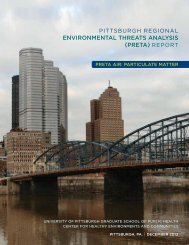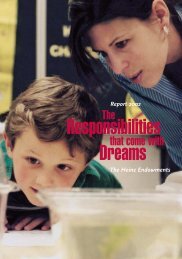View PDF - Heinz Endowments
View PDF - Heinz Endowments
View PDF - Heinz Endowments
You also want an ePaper? Increase the reach of your titles
YUMPU automatically turns print PDFs into web optimized ePapers that Google loves.
Low-income children are no longer_solely concentrated in the inner city but are progressively<br />
moving to municipalities outside the City of Pittsburgh. This trend is likely ro contiiue as the federal<br />
Department of Housing and Urban Development progressively dismantles public housing projects and<br />
encourages their residents to disburse throughout the metropolitan area.<br />
Low-income children are located in three types of geographic locations:<br />
- Neighborhoods in the City of Pittsburgh having high poverty rates -- including Fairywood, St.<br />
Clair, Terrace Village, Arlington Heights, Northview Heights, and Bedford Dwellings.<br />
- School districts having high percentages of children eligible for the National School Lunch<br />
Program -- including Duquesne City (89Eo eligible), Wilkinsburg (8l%o),Sto-Rox (79%o),Clairton<br />
Ç¡!y {4U"¡, City of Pittsburgh (6lVo), McKeesport City (56qò,Sieel Valley (52Vo),andWoodtand<br />
Hills (517o). These districts, plus Penn Hills and West Mifflin, also represénr municipalities with<br />
more than 100 children currently enrolled in TANF.<br />
- Individual elementary schools with substantially higher percentages of children eligible for<br />
free or reduced lunch than the overall rate in their districts -- including Franklin el07o of<br />
enrolled children eligible) and Barrett (857o) both in Steel Valley School District, Veiona (67Vo) in<br />
Riverview District, Grandview (63Vo) in Highlands District, Pitcairn (557o) in Gateway District,<br />
Reserve (42Vo) and Marzolf (367o) both in Shaler Area Districr, Kerr (28Vo) in Fox Chãpel Distiict,<br />
and Hyde (27Vo) in Moon Area District.<br />
Currentlyn school districts in the County having relatively high numbers or percentages of<br />
children not served by existing nonschool-hour services incluãe the City of piìtsburgh (zl,zqq<br />
children or 77Vo not served), Woodland Hills (3,904 ,91Vo), Penn Hills (3,i14,9}Vo),NfcKeesport<br />
Atea(2,656,7\Vo),West Mifflin(2,040,99Vo), Steel Valley (1,576,99Vo),Wilkinsburg (1,184, 74Vo),<br />
Clairton City (657, 95Vo), and Duquesne City (589, gg7o).<br />
The areas in which there is particular need for services relative to the number of low-income<br />
child¡en are represented graphically in Map 2 (for the City of Pittsburgh) and Map 3 (Municipalities<br />
of Allegheny County) in Appendix II. The maps show in maroon and red shaãed areas the<br />
location of substantial numbers of low-income children as determined by school lunch enrollments, and<br />
the locations of nonschool-hour programs in large green concentric ciicles (Child Care partnership<br />
programs) or red circles (from OCD's community survey). Red or maroon areas with small and/or<br />
fewer dots represent the areas of greatest disparity between needy populations and availability of<br />
programs as mentioned above.<br />
The dispersion of poYerly throughout the County means that simply targeting services at impoverished<br />
inner'city neighborhoods is not sufficient. As low-income õtrit¿reñ coniinue to spread<br />
throughout the County, geographic targeting of services becomes more difficult, less effective, and<br />
unfair to those low-income children who do not live in areas of substantial concentration of poverty.<br />
Ultimately, other strategies of targeting assistance must be adopted; for example, subsidies ór vouðhers<br />
for individual families, sliding-fee scales and agency subsidies or reimbursements, universal programs<br />
available to all, and perhaps other innovative approaches.







